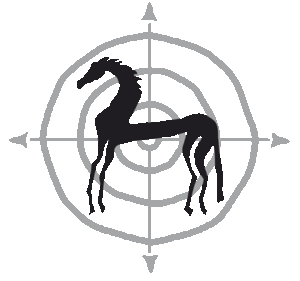How to ride the best working tempo on any horse
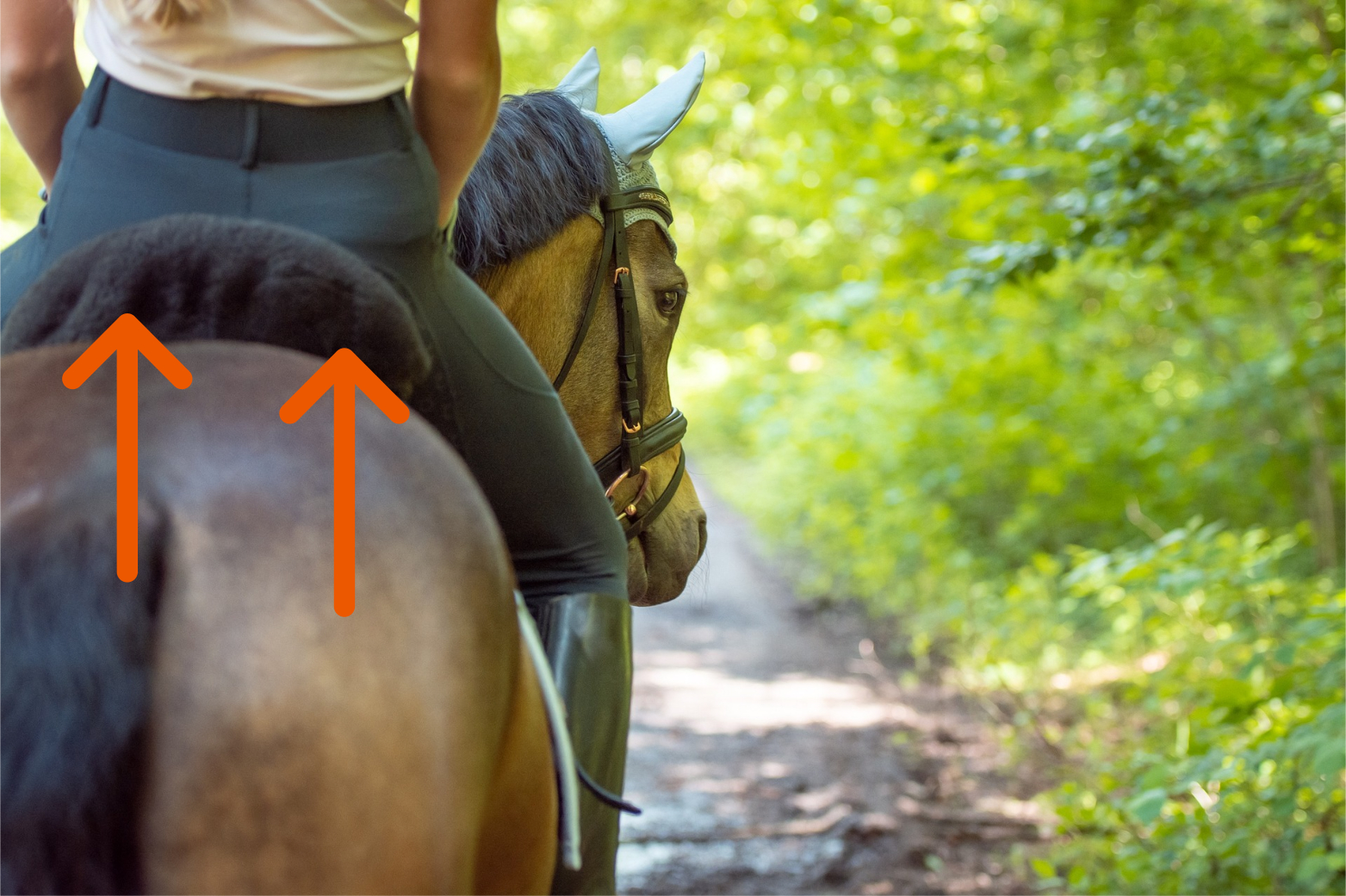
Do you know how to ride the best working tempo on any horse? If yes, this will help a lot in keeping your own horse healthy and happy. Even better: it will help you improve every horse you ride!
In our earlier posts, you could read why it’s so important to ride your horse in the optimal tempo (find it here)– and how the best working tempo can be very different from horse to horse (find it here). It can even be different from minute to minute for the same horse!
In this post we will look at how you, as a rider, can figure out what the best working tempo is for your horse – and even better, for any horse. And why this knowledge is essential for preventing back and tendon problems in horses.
You will also find some easy exercises you can do on your next ride. Read on and try it out!
Relaxed and active – not on the forehand
To recap from our earlier blogposts on this subject (you can find them here and here):
If we want to keep our horse healthy, we have to make sure he uses his body in a way that does not cause unnecessary wear and tear.
That means the horse should go ‘in balance’ – not ‘on the forehand’.
The horse should be mentally relaxed, but not lazy or unresponsive. And his steps should be active, but not hasty or choppy.
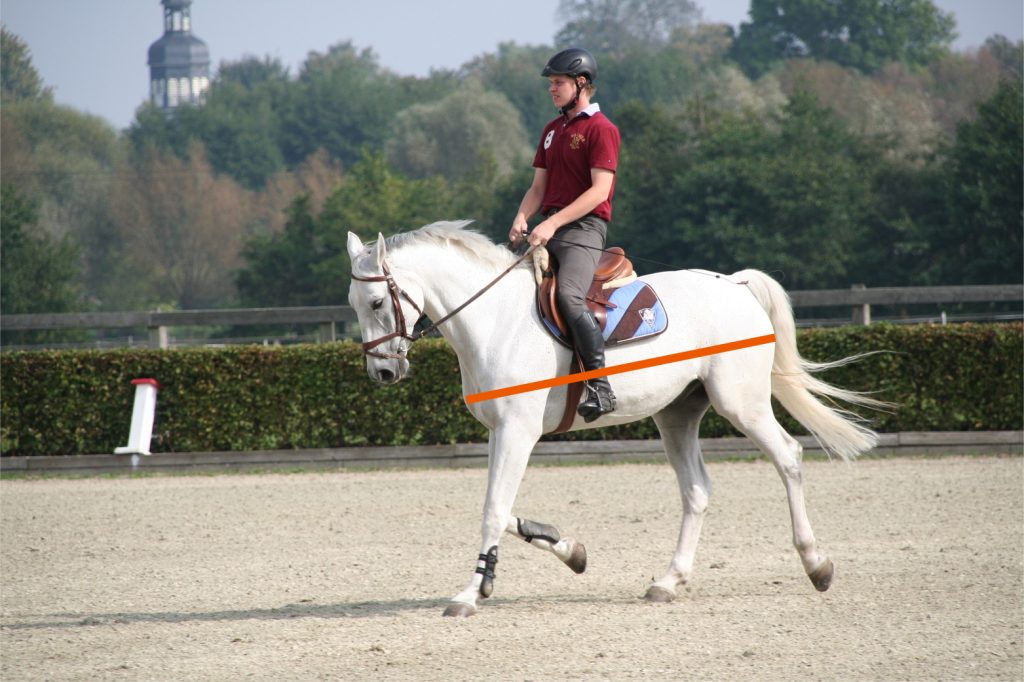
This horse is ‘on the forehand’. His hindlegs are not stepping under and ‘carrying’ him, and his frontlegs will be overloaded at every step.
Can I see the best tempo when I am riding my horse?
The bad news: You cannot SEE if the horse is moving actively and in balance while you are riding him. After all, you can only see his head, neck and shoulders – not his legs or his back.
The good news: you can FEEL it.
You can feel his movement through the saddle.
And you can feel in your own body how much the horse moves you.
For example: when he takes a step in walk, your horse will push up one of your hips. The next step, he will push up your other hip. If he takes bigger steps, your hips will be pushed up higher.
At the same time, your pelvis will be going forwards and backwards with his steps. Bigger steps? More movement there, too.
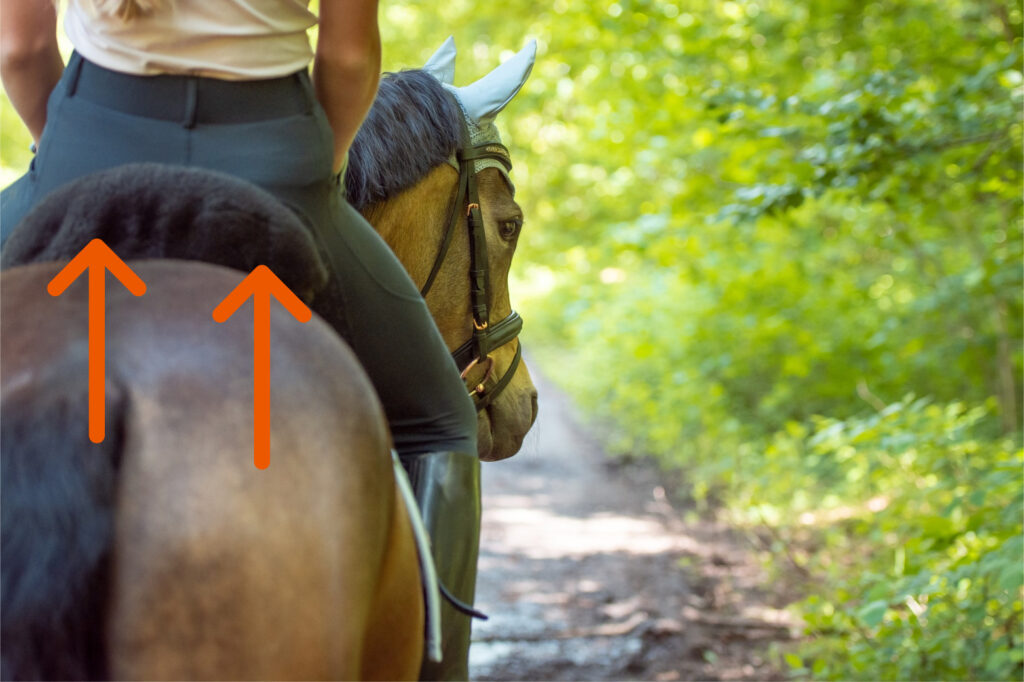
You can feel through the saddle how your horse moves your hips and your pelvis. This will tell you how his steps are.
Riding the waves
You can think about it like ‘riding the waves’ (a bit like a surfer).
When you are riding, you can feel the horse moving under you through the saddle. It almost feels like waves under you.
If you can feel how these ‘waves’ under you change, it will tell you how the steps of your horse are changing.
Slow, low and short waves

Maybe your horse starts out a bit stiff and lazy. He is taking short and slow steps, and he is not really lifting his feet.
You will feel that through the saddle as small, low waves.
We want our horses to be relaxed in their work, of course. But if he is not lifting his feet and moving his legs with some energy, his body will not get much of a workout. If he was a human, you would say he is ‘window shopping’, instead of going for a brisk walk.
Quick, short and ‘choppy’ waves

Maybe you ask your horse to go a bit faster, so he gets more of a workout. The aim is to get him to take longer and more active steps.
However, when asked to increase their tempo, some horses will instead start taking quicker but shorter steps. This will feel like short little waves under you.
Especially horses and ponies that don’t have ‘big gaits’ naturally might try to do this. For them, taking longer and more active steps means a real workout. So they avoid the question by moving like a little ‘sewing machine.’
Some smaller ponies, for example, might move in this way. But also bigger ponies and horse that for some reason cannot or do not want to take longer steps.
This kind of movement might actually feel quite comfortable for the rider – those little short waves make for a fairly ‘smooth’ ride. But it’s usually not the best kind of movement for a good physical development of your horse.
Long waves that tip forward

There are horses that actually do move with a lot of power coming from their hind legs, and they do take long steps – but their hind legs ‘push’ more than they ‘carry’.
In other words, the horse pushes off with a lot off power, but his hind legs do not step under his body enough. So the horse tips onto his forehand.
As we have seen, this is not what we want for our riding horse.
The waves under you will feel rather large, and at the same time you will feel that you are being tipped forward a bit.
Many nice young horses with good movements will move like this when they first are started under the saddle (until they are taught to move in a more balanced way).
It’s also something which is quite common in horses that are higher behind than in front. And even more so if such a ‘downhill’ horse moves with a lot of energy, for example a Thoroughbred or a Warmblood Trotting Horse.
High and bouncy waves

Maybe your horse gets excited about something and starts ‘dancing’ under you with high and bouncy steps. This then will feel like high and bouncy waves that go more ‘up’ than forward.
This can be totally fine – as long as your horse doesn’t get too excited!! Those bouncy steps should preferably be something that the rider has asked for, and that the rider can control. If your horse tends to move like this a lot of the time, it can be a clear signal that he needs more hours outside and/or a bigger paddock. And a buddy to play with, too.
Too much concentrates (such as oats) can also cause a very bouncy and ‘fresh’ horse.
These waves actually are what you want to feel under you if you are aiming for a collected walk, trot or canter. And even more so in piaffe and passage. (But again, preferably asked for and controlled by the rider – not just ‘something the horse does’.)
Uneven waves

Does it feel like the waves are not the same on each side? That means your horse is moving with uneven steps.
Maybe he is stiffer on one side. But it can also mean there is a problem brewing, such as back pain or lameness.
It can also be caused by the rider… for example, if you are not sitting straight in the saddle.
If a horse moves with uneven steps, it’s time to find some help. Maybe your riding teacher can ride your horse and find out if she feels the same unevenness.
But if the horse still moves unevenly with a more experienced rider, it’s a good idea to ask your veterinarian to have a look.
How to ride the best working tempo on any horse

The optimal working tempo is usually the one where you feel a high and long wave under you.
If you can feel that kind of ‘wave’ under you, it means the horse is really using his hind legs in a good way. And that his back muscles are working freely and ‘swinging’.
But the best working tempo (and the wave you should feel) also depends on what gait or exercise you want to ride.
For example: in an extended trot, your horse’s steps should be longer than in a regular trot. This means that the wave also should feel longer.
If you try to ride an extended trot and you feel that the horse takes quick, short and ‘choppy’ steps, then you know that this was not a good extended trot. Which also means the rider should do some thinking. Can my horse do this exercise? Is he strong enough? Did I ask him in the right way? And so on.
If you want to ride a collected trot, your horse should trot with shorter steps. In a good collected trot, however, the steps should not just be short, but also higher and with a bit more ‘bounce’. If the wave under you just feels short and flat, this will tell you that you did not ride a good enough collected trot. So the rider will have to figure out a better approach next time she tries it.
Help! What’s the right wavelength for MY horse?
Sometimes it can be hard to feel exactly how the wave should feel to get the best results with your horse.
For example: some horses naturally move with a lot more ‘bounce’ than other horses. Which can make it hard for the rider to figure out if the horse is actually moving the way he should.
The steps might feel energetic, but actually be too hasty.
Or they might feel too slow, but actually be just right for a big-moving horse.
This is where some ‘eyes on the ground’ can be very helpful.
If you don’t have a riding teacher available who can teach you about the best working tempo for your horse, you can ask somebody to film you. It will only take a few minutes, and it can very helpful to figure this out.
TIP: Here at HorseCompass, we offer both ‘live’ and video lessons. Feel free to get in touch to discuss the possibilities.
Helpful exercises: Try this on your next ride!
Next time you ride, ‘surf around’ on your horse.
- Ride in walk on a straight line, with fairly loose reins.
- Feel how the horse moves your body.
- Feel how one of your hips goes up, and then the other.
- Also feel how your pelvis moves forwards and backwards.
- After that, try the same in a bit faster walk and a bit slower walk. Try to feel the difference in the waves.
Maybe a friend can lead your horse while you do this exercise? Then you can really concentrate on feeling what is happening under you.
Can somebody film you?
Is there somebody who can film you? It will only take a few minutes to do this next exercise:
- Ride in walk on a straight line (for example, on the track next to the fence or the wall).
- Say loudly what kind of ‘wave’ you are feeling under you (long or short, high or low).
- Then you ask your horse to walk a bit faster. Say loudly how the wave feels now.
- Then, ask your horse to walk a bit slower. Again, say how his back feels under you at that speed.
- If you want, you can do the same in trot and canter.
Remember to say loud and clear how the ‘wave’ feels under you at the different speeds.
When you look at the video later, you can compare what you were feeling under you, to how your horse looks from the ground.
You can also show the video to your riding teacher and get her feedback on which ‘wavelength’ she thinks is the best working gait for your horse.
What good trainers and teachers do
Every trainer should always aim for the optimal working gait/tempo for each horse, at any time. And remember: the best tempo for the horse you are riding might change from day to day – and even from minute to minute.
Every good riding teacher should teach their students how to figure out the optimal tempo for their horse early in the student’s riding career.
This is something every rider should learn, regardless of their riding ambitions.
Because what is the use of riding around and around, doing all kinds of figures or exercises, if your horse is unbalanced and on the forehand – or so slow and ‘strung out’ that his hind legs seem to be in the next town…? Actually, no use at all!
Back problems and tendon damage
Letting your horse continuously go too slow or too fast most of the time will, at best, make your training fairly useless.
But much worse than that: there is a good chance your horse will end up with all kinds of back problems and even with tendon damage.
Of course, no trainer or riding teacher can work on ‘everything at the same time’.
But working on finding a good working tempo (and/or teaching your students how to recognize this) is essential in keeping your horse healthy.
Unfortunately, many riders and trainers are confused about this. They think ‘working’ a horse just means riding at a fast speed.
Many nice and well-moving horses and ponies are continuously ridden in too high a tempo. And many of these horses end up with damaged bodies – and often an early death – just because of this.
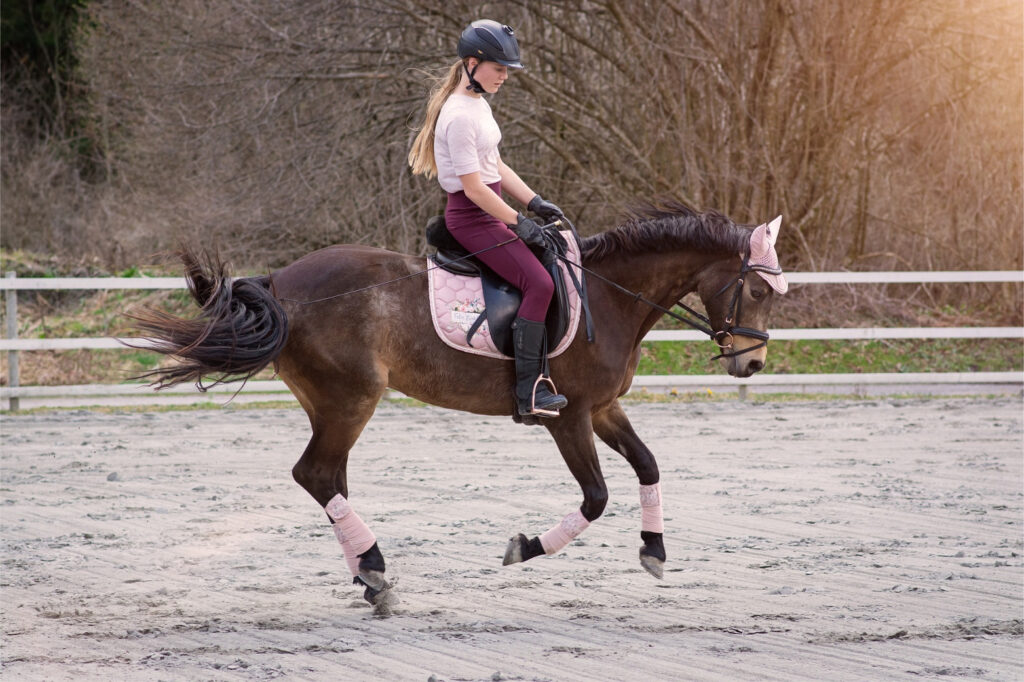
The best working tempo has nothing to do with speed. Continuously riding your horse or pony too fast and unbalanced will set him up for back problems and lameness.
Bad news 1: Your job as a rider
The bad news: to be able to ‘feel’ the right tempo for your horse, the rider must have a balanced and independent seat.
After all: it is hard to feel anything if you are clamping on to the saddle with your knees and thighs…
Every rider should learn how to sit quietly and relaxedly in the saddle. And how to stay on a horse by sitting in balance, not by gripping the saddle.
To feel how the horse moves under you, the muscles in your leg and butt should be relatively ‘soft’- not holding your horse in a death grip!
This is why good riding teachers work so much on helping you find that balanced and relaxed seat.
A ‘good seat’ will make you a much better rider, whatever kind of riding you want to do.
It will also make your horse a lot happier!
Bad news 2: Is your saddle a problem?
Saddles and saddle fit are a subject that could fill many, many blog posts all by itself.
We will not go into that in this post – but it must be mentioned that a well-fitting saddle is essential to let the rider sit balanced and relaxed. And as we just mentioned, that good seat is essential to be able to ride the best working tempo.
Some saddles make it impossible for the rider to sit balanced and (relatively) relaxed. To give an example: if the saddle is too narrow for the horse, it will be too high in front (over the horses’ withers). Which means the rider will end up leaning back in a so-called ‘chair seat’. In that position it can be very hard for a rider to feel what is happening under you.
If you want to have any success at riding good working gaits, your saddle should allow you to sit balanced without squeezing.
Not only that: if your saddle doesn’t fit your horse and hurts him – it will be REALLY hard to get him to do any kind of decent working gait!
Don’t miss our next blog post!
Don’t risk missing out – sign up here, and our next blog posts will automatically land in your inbox.
BONUS: you will get this FREE E-BOOK! With 10 easy tips how you can be a better rider, already today. Because our horses deserve that we are the best riders we can be.
Any questions or comments? Feel free to share with us in the comments.
We love feedback and will try to get back to you as quickly as possible.
